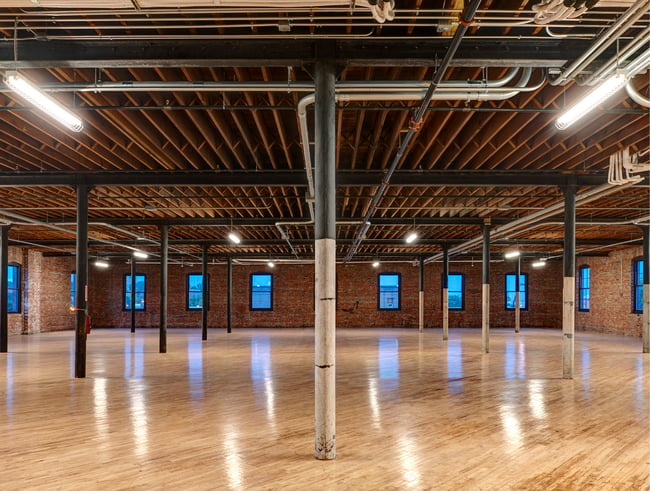Exploratory Demolition for Renovations or Adaptive Reuse Projects

Starting a renovation or an adaptive reuse project can be intimidating. Existing buildings can come with unforeseen conditions, presenting additional risks during construction.
To formulate a design plan, your architect will likely need to investigate the building’s existing conditions. They may even recommend exposing or removing some building elements—a process called exploratory demolition.
We’ve worked on many adaptive reuse projects—including Market One in Des Moines, Fort Des Moines, and the Stanley Center for Peace and Security. In our experience, exploratory demolition can minimize risks during construction and help with budgeting.
This article will discuss exploratory demolition in more detail and explain how to prepare.
What is Exploratory Demolition?
Exploratory demolition—also known as partial demolition—is the process of exposing or removing elements of an existing building to observe their condition and determine if anything needs to be repaired, modified, or replaced.
Any renovation or adaptive reuse project will involve an observation of existing conditions, but some buildings may require a deeper analysis. Older structures—especially those covered by years of modifications—may require partial demolition before your design team can determine the best path forward.
An architect may recommend this process to gain a better understanding of elements like:
- Structural systems
- Mechanical, electrical, and plumbing systems
- Architectural elements, like façade treatments and floors
For example, they may need to peel back layers to determine electrical conduit or plumbing routes. On a recent project, we removed metal panels from a former renovation to investigate the state of the historic brick. This process helped the team determine if they should expose the original brick or explore another façade treatment option.

Exploratory demolition can help evaluate the state of architectural elements.
Exploratory demolition can also help catch potential issues like mold, water damage, or the presence of hazardous materials. By removing building elements, your design team can better understand the work ahead, leading to a more accurate budget and construction schedule.
The process is like taking soil borings. On a new construction project, a geotechnical engineer will drill holes to take samples of the soil and bedrock. This information can help your design team plan foundations.
Like soil borings, exploratory demolition analyzes a small sample. It cannot catch every issue, and unforeseen conditions may still arise during construction. Your design team should factor a construction contingency into your budget to account for other potential surprises.
How Can You Prepare for Exploratory Demolition?
While your design team will observe the site conditions, they are not the ones to perform demolition work. Instead, you will need to hire a contractor to assist with exploratory demolition.
Some organizations or developers will have an existing relationship with a contractor and choose to hire them directly. In other cases, your architect can recommend someone to assist.
Depending on the extent of the demolition, your municipality may require a building permit. You should also be prepared to either repair demolished elements or leave them exposed until construction begins. Your design team can limit their investigation to areas unlikely to impact your operations.
The process may require some upfront costs—and it can create a temporary eyesore. However, the expense should be thought of as a development cost—an investment that will help protect your budget down the road. By exploring existing conditions, your design team can account for repairs and replacements in the construction budget and create a more accurate design.
Starting an Adaptive Reuse Project
Although existing structures present additional risks, upfront research can help minimize surprises. Exploratory demolition may be necessary for older structures without updated documentation. By removing existing building elements, your design team can better understand the building’s condition and formulate a plan for the work ahead.
Despite the risks, reusing an existing structure offers many benefits. It can help preserve your community’s identity and lower your embodied carbon footprint. Reuse minimizes the emissions and waste associated with demolition and new construction, making it one of the most sustainable choices you can make.
Existing buildings may also present additional funding opportunities, including historic tax credits and brownfield development grants. We recommend accounting for these potential opportunities when selecting a site for your project. Learn more by reading about good fits for an adaptive reuse project.